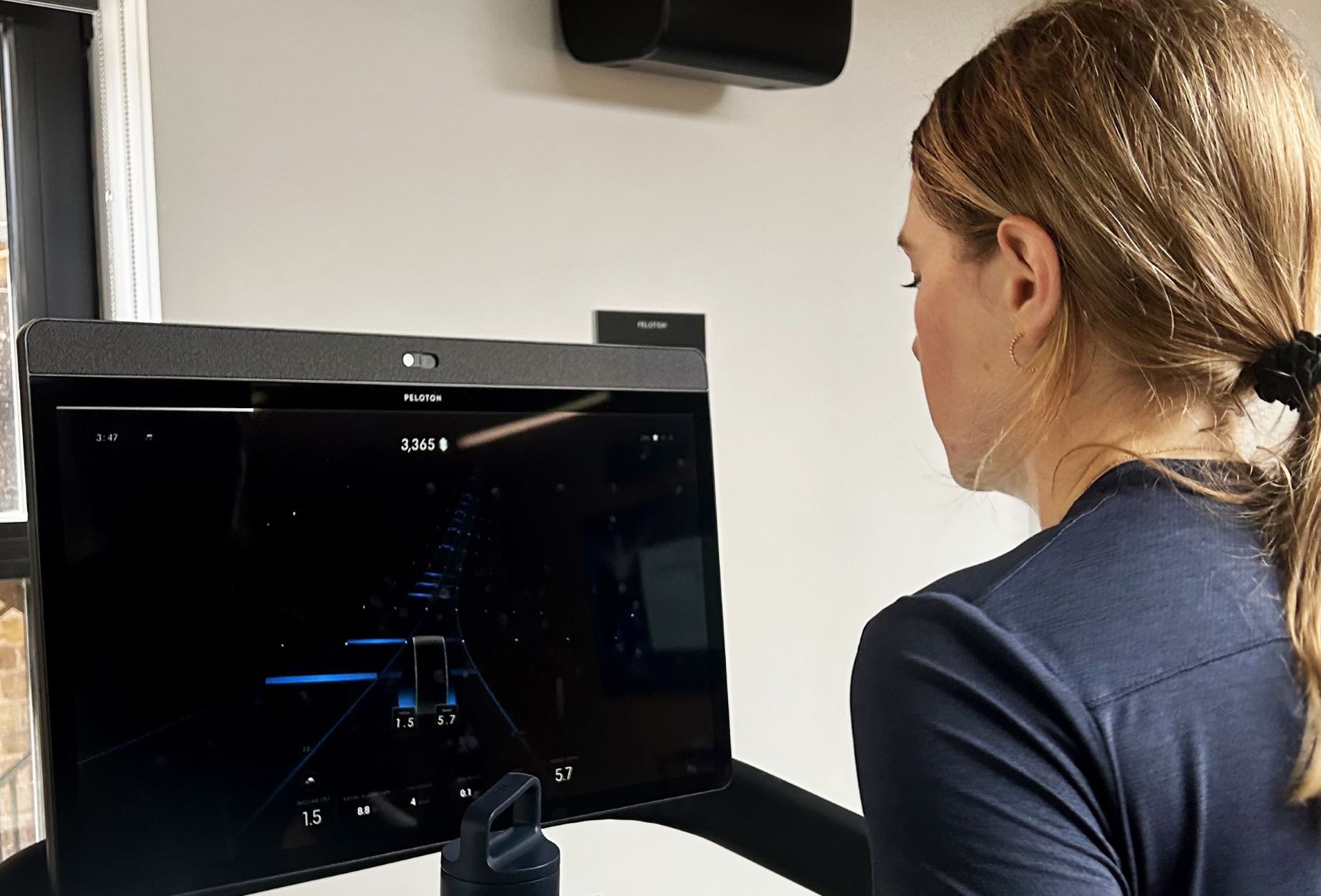Home>Training & Techniques>Comparing The Effectiveness Of Treadmill Running To Outdoor Running


Training & Techniques
Comparing The Effectiveness Of Treadmill Running To Outdoor Running
Published: March 3, 2024
Discover the best training and techniques for running with our comparison of treadmill and outdoor running, and find out which is more effective for your fitness goals.
(Many of the links in this article redirect to a specific reviewed product. Your purchase of these products through affiliate links helps to generate commission for Therunningadvisor.com, at no extra cost. Learn more)
Table of Contents
Introduction
Running is a popular form of exercise that offers a myriad of physical and mental benefits. Whether you prefer the controlled environment of a treadmill or the invigorating experience of outdoor running, both options have their unique advantages. The debate over the effectiveness of treadmill running versus outdoor running has sparked interest among fitness enthusiasts and researchers alike. Understanding the nuances of each form of running can help individuals make informed decisions about their fitness routines.
In this comprehensive comparison, we will delve into the distinct benefits and considerations associated with treadmill running and outdoor running. By examining the physical and mental impacts, calorie burn, and muscle engagement of each type of running, we aim to provide valuable insights for individuals seeking to optimize their running experience. Whether you are a seasoned runner or someone considering incorporating running into your fitness regimen, this exploration will shed light on the factors to consider when choosing between treadmill and outdoor running.
Benefits of Treadmill Running
Treadmill running offers a range of benefits that cater to the diverse needs and preferences of runners. Whether you are a beginner looking to establish a consistent running routine or a seasoned athlete aiming to enhance your performance, the treadmill provides a controlled and versatile platform for achieving your fitness goals.
-
Convenience and Accessibility: One of the primary advantages of treadmill running is the convenience it offers. With a treadmill, you can lace up your running shoes and commence your workout without being restricted by factors such as weather conditions or time of day. This accessibility eliminates the need to plan routes or travel to specific locations, making it an ideal option for individuals with busy schedules.
-
Customizable Terrain and Incline: Treadmills allow runners to adjust the terrain and incline according to their training objectives. Whether simulating uphill climbs or incorporating interval training, the ability to customize the running surface enables individuals to target specific muscle groups and enhance their overall endurance.
-
Controlled Environment: Treadmill running provides a controlled environment that is free from external variables such as uneven surfaces, traffic, and unpredictable weather. This controlled setting can be particularly beneficial for individuals recovering from injuries or those seeking a consistent and predictable running experience.
-
Monitoring and Tracking: Modern treadmills are equipped with advanced monitoring features that enable runners to track essential metrics such as heart rate, distance covered, and calories burned. This real-time feedback empowers individuals to monitor their progress and make informed adjustments to their workouts, contributing to a more effective and goal-oriented training regimen.
-
Safety and Security: For individuals who prioritize safety during their workouts, treadmill running offers a secure alternative to outdoor running. This is especially relevant for those who prefer to exercise during early morning or late evening hours when outdoor conditions may pose potential risks.
In summary, the benefits of treadmill running encompass convenience, customizable terrain, a controlled environment, monitoring capabilities, and enhanced safety. These advantages make treadmill running an appealing option for individuals seeking a versatile and adaptable platform to pursue their fitness endeavors.
Benefits of Outdoor Running
Outdoor running offers a plethora of benefits that cater to the physical, mental, and emotional well-being of individuals. The experience of running amidst natural surroundings provides a unique and invigorating platform for fitness enthusiasts to engage with their environment while reaping the rewards of outdoor physical activity.
Connection with Nature
The opportunity to immerse oneself in natural surroundings is a defining advantage of outdoor running. Whether it's the serene beauty of a park, the refreshing breeze along a coastal path, or the scenic trails of a forest, outdoor running allows individuals to connect with nature. This connection can have a profound impact on mental well-being, offering a sense of tranquility and rejuvenation that is distinct from the indoor environment of a gym or treadmill.
Varied Terrain and Challenges
Outdoor running presents runners with diverse terrains and natural obstacles, such as hills, trails, and varying surfaces. Negotiating these challenges engages a wider range of muscles and enhances balance and coordination. The dynamic nature of outdoor terrain also contributes to the development of agility and adaptability, making outdoor running an effective way to improve overall physical fitness.
Vitamin D Absorption
Exposure to natural sunlight during outdoor running facilitates the body's production of vitamin D, a vital nutrient that supports bone health, immune function, and overall well-being. The absorption of vitamin D through sunlight exposure can contribute to a runner's overall health and vitality, making outdoor running a holistic and beneficial form of exercise.
Mental Stimulation and Stress Reduction
The ever-changing outdoor environment provides mental stimulation that can alleviate stress and enhance cognitive function. The sights, sounds, and smells of the outdoors create a sensory experience that can uplift mood and reduce feelings of anxiety and fatigue. Additionally, the open spaces and natural surroundings offer a sense of freedom and liberation that can have a positive impact on mental well-being.
Community Engagement and Social Connection
Outdoor running often provides opportunities for community engagement and social connection. Whether participating in local running events, joining running groups, or simply encountering fellow runners along popular routes, outdoor running fosters a sense of camaraderie and shared enthusiasm for fitness. This social aspect can contribute to a runner's motivation and overall enjoyment of the activity.
In summary, outdoor running offers a holistic and enriching experience that encompasses a connection with nature, varied terrain and challenges, vitamin D absorption, mental stimulation, and social engagement. These benefits make outdoor running a compelling choice for individuals seeking to integrate physical activity with the rejuvenating elements of the natural world.
Factors to Consider when Comparing Effectiveness
When evaluating the effectiveness of treadmill running versus outdoor running, several key factors come into play, influencing the overall impact of each form of exercise. These factors encompass the physiological, psychological, and practical aspects of running, and understanding them is essential for individuals seeking to make informed decisions about their preferred running environment.
Physiological Impact
Physiologically, both treadmill running and outdoor running offer distinct benefits and challenges. Treadmill running provides a controlled surface and environment, allowing individuals to focus on specific training objectives such as speed, incline, and endurance. In contrast, outdoor running introduces natural elements and varied terrain, engaging a broader range of muscles and enhancing balance and coordination. Considering the physiological impact involves assessing the specific fitness goals, muscle groups, and overall physical conditioning that individuals aim to achieve through their running regimen.
Psychological and Emotional Factors
The psychological and emotional dimensions of running play a significant role in determining its effectiveness. Treadmill running offers a controlled and predictable setting, which can be conducive to maintaining a consistent running routine and monitoring progress. On the other hand, outdoor running provides a sensory-rich experience, connecting individuals with nature and offering mental stimulation that can alleviate stress and enhance mood. Evaluating the psychological and emotional factors involves recognizing the individual's preferences for environmental stimuli, stress reduction, and overall mental well-being during their running sessions.
Practical Considerations
Practical considerations encompass the logistical aspects of running, including accessibility, time constraints, safety, and equipment. Treadmill running offers unparalleled convenience and accessibility, eliminating the need to plan routes or contend with external factors such as weather conditions. Outdoor running, while offering a connection with nature and varied terrain, requires additional planning and consideration for factors such as weather, safety precautions, and access to suitable running routes. Assessing practical considerations involves weighing the individual's lifestyle, schedule, and preferences for convenience and environmental engagement.
Training Adaptability and Long-Term Sustainability
The adaptability of training methods and the long-term sustainability of a running regimen are crucial factors to consider. Treadmill running allows for precise control over training variables, making it suitable for targeted workouts and specific training programs. Outdoor running, with its dynamic terrain and natural challenges, promotes adaptability and can contribute to the overall sustainability and enjoyment of a running routine. Evaluating training adaptability and long-term sustainability involves considering the individual's fitness goals, motivation, and preferences for training diversity and long-term engagement with the activity.
In essence, comparing the effectiveness of treadmill running to outdoor running requires a comprehensive assessment of physiological impact, psychological and emotional factors, practical considerations, and training adaptability and long-term sustainability. By carefully considering these factors, individuals can make informed choices that align with their fitness goals, preferences, and overall well-being.
Read more: Top Treadmill Workouts For Runners
Physical and Mental Impact of Treadmill Running
Treadmill running exerts a significant influence on both the physical and mental aspects of an individual's well-being. From enhancing cardiovascular health to contributing to mental clarity, the impact of treadmill running extends beyond the physical act of exercise.
Physical Impact
Cardiovascular Health and Endurance
Treadmill running serves as an effective cardiovascular workout, promoting heart health and endurance. The consistent rhythm of treadmill running elevates heart rate, strengthening the heart muscle and improving overall cardiovascular function. This sustained aerobic activity contributes to enhanced endurance, allowing individuals to gradually increase their running duration and intensity, thereby improving their cardiovascular capacity over time.
Joint Impact and Injury Prevention
The cushioned surface of treadmills provides a lower-impact environment compared to outdoor running on concrete or asphalt. This reduced impact can be beneficial for individuals with joint sensitivities or those recovering from injuries. Treadmill running minimizes the stress on joints, particularly the knees and ankles, potentially lowering the risk of impact-related injuries and allowing individuals to engage in consistent running routines with reduced physical strain.
Muscular Engagement and Conditioning
Treadmill running engages a specific set of muscles, primarily focusing on the lower body, including the quadriceps, hamstrings, calves, and glutes. The consistent motion of treadmill running contributes to muscle conditioning and toning, particularly in the lower body muscles. Additionally, the incline feature of treadmills enables individuals to target specific muscle groups, such as the glutes and calves, by adjusting the incline level, thereby enhancing overall muscular strength and endurance.
Mental Impact
Stress Reduction and Mental Clarity
Engaging in treadmill running can have a profound impact on mental well-being. The rhythmic motion and focused nature of treadmill running can serve as a form of meditation, allowing individuals to clear their minds and alleviate stress. The release of endorphins during treadmill running can contribute to a sense of mental clarity and relaxation, reducing feelings of anxiety and promoting overall mental well-being.
Goal-Oriented Focus and Monitoring
Treadmill running provides a structured and goal-oriented platform for individuals to monitor their progress and set specific targets. The ability to track metrics such as distance covered, speed, and calorie expenditure fosters a sense of accomplishment and motivation. This goal-oriented focus can contribute to a positive mindset and a sense of achievement, enhancing the mental impact of treadmill running.
In summary, treadmill running exerts a multifaceted impact, encompassing cardiovascular health, joint impact and injury prevention, muscular engagement, stress reduction, mental clarity, and goal-oriented focus. Understanding the physical and mental implications of treadmill running can empower individuals to harness these benefits and integrate treadmill running into their fitness routines for holistic well-being.
Physical and Mental Impact of Outdoor Running
Outdoor running encompasses a holistic approach to physical and mental well-being, offering a diverse range of benefits that extend beyond the act of exercise. The impact of outdoor running is multifaceted, influencing cardiovascular health, muscular engagement, mental clarity, and emotional well-being in profound ways.
Physical Impact
Cardiovascular Endurance and Health
Outdoor running serves as a dynamic cardiovascular workout, challenging the heart and lungs to adapt to varying terrains and environmental conditions. The fluctuating surfaces and natural obstacles encountered during outdoor running demand continuous adjustments in pace and stride, leading to enhanced cardiovascular endurance. The cardiovascular system is stimulated by the combination of uphill climbs, downhill descents, and flat terrains, contributing to improved heart health and overall endurance.
Full-Body Engagement and Balance
Unlike treadmill running, outdoor running engages a wider range of muscles throughout the body. Negotiating natural terrains, such as trails, grassy paths, or sandy beaches, requires the activation of stabilizing muscles, enhancing overall balance and coordination. The uneven surfaces and natural obstacles encountered during outdoor running promote full-body engagement, including the core, hips, and stabilizing muscles, contributing to a more comprehensive and functional form of exercise.
Joint Flexibility and Strength
The varied surfaces and natural undulations of outdoor terrain promote joint flexibility and strength. The adaptability required to navigate uneven paths and natural obstacles fosters joint mobility and resilience. Additionally, the impact of outdoor running on natural surfaces can contribute to the strengthening of connective tissues and supporting structures, potentially reducing the risk of overuse injuries and promoting long-term joint health.
Mental Impact
Connection with Nature and Stress Reduction
Outdoor running provides a unique opportunity to connect with nature, offering a sensory-rich experience that can alleviate stress and promote mental well-being. The sights, sounds, and scents of the outdoors create a tranquil and rejuvenating environment, allowing individuals to escape the pressures of daily life and immerse themselves in the natural world. This connection with nature can have a calming and grounding effect, reducing stress and enhancing mental clarity.
Mindfulness and Emotional Resilience
The ever-changing outdoor environment encourages mindfulness and emotional resilience. The need to adapt to varying terrains and weather conditions fosters a sense of presence and awareness, promoting mindfulness during the act of running. Additionally, the challenges and triumphs experienced during outdoor running can contribute to emotional resilience, instilling a sense of accomplishment and fortitude that transcends the physical aspects of exercise.
In summary, outdoor running exerts a profound impact on physical and mental well-being, encompassing cardiovascular endurance, full-body engagement, joint flexibility, connection with nature, stress reduction, mindfulness, and emotional resilience. Embracing the holistic benefits of outdoor running can empower individuals to cultivate a balanced and enriching approach to their fitness and overall well-being.
Comparison of Calorie Burn
When comparing the calorie burn between treadmill running and outdoor running, several factors come into play, influencing the overall energy expenditure and metabolic impact of each form of exercise. Both treadmill running and outdoor running offer effective means of burning calories, yet the specific nuances of each environment contribute to variations in calorie burn.
Treadmill running provides a controlled and consistent platform for calorie expenditure. The ability to set and maintain a specific pace, incline, and duration enables individuals to engage in targeted calorie-burning workouts. Modern treadmills equipped with heart rate monitors and calorie tracking features allow runners to monitor their energy expenditure in real time, providing valuable insights into their calorie burn during each session. The controlled environment of treadmill running eliminates external variables such as wind resistance and uneven terrain, allowing individuals to sustain a consistent level of effort, which can contribute to a predictable and measurable calorie burn.
On the other hand, outdoor running introduces natural elements and environmental factors that can influence calorie burn. The varying terrains, inclines, and weather conditions encountered during outdoor running demand continuous adjustments in effort, leading to fluctuations in energy expenditure. Uphill climbs, uneven surfaces, and headwinds present inherent challenges that require additional energy output, potentially leading to a higher overall calorie burn compared to treadmill running. Additionally, the sensory-rich experience of outdoor running, including exposure to natural sunlight and environmental stimuli, can contribute to an enhanced metabolic response, further influencing calorie burn.
The impact of calorie burn during outdoor running is also influenced by factors such as temperature, humidity, and terrain variability. Running in challenging outdoor conditions, such as hot and humid weather or hilly terrains, can elevate the body's metabolic rate, leading to increased calorie burn. Furthermore, the engagement of stabilizing muscles and the adaptability required to navigate outdoor terrain can contribute to a more comprehensive and energy-intensive form of exercise, potentially resulting in a higher calorie burn compared to treadmill running.
In essence, the comparison of calorie burn between treadmill running and outdoor running reflects the interplay of controlled environment versus natural elements, consistent effort versus adaptive challenges, and predictable metrics versus dynamic stimuli. Both forms of running offer effective means of burning calories, yet the specific attributes of each environment contribute to variations in energy expenditure. Understanding the distinct metabolic impacts of treadmill running and outdoor running can empower individuals to make informed choices based on their fitness goals and preferences for calorie-burning activities.
Comparison of Muscle Engagement
When comparing the muscle engagement between treadmill running and outdoor running, it becomes evident that each form of exercise elicits distinct patterns of muscular activation and involvement. The differences in terrain, surface variability, and environmental conditions contribute to unique muscle recruitment and engagement during treadmill and outdoor running.
Treadmill running primarily engages the lower body muscles, including the quadriceps, hamstrings, calves, and glutes. The consistent motion of treadmill running, combined with the option to adjust incline levels, targets these specific muscle groups, promoting muscular endurance and strength. The controlled surface of the treadmill provides a stable platform for repetitive motion, allowing individuals to focus on the engagement of these lower body muscles without the added challenge of navigating uneven terrain. Additionally, the cushioned surface of treadmills reduces impact on joints, potentially minimizing stress on the lower body muscles while promoting sustained muscular engagement.
In contrast, outdoor running engages a broader range of muscles throughout the body. The varied terrains and natural obstacles encountered during outdoor running necessitate the activation of stabilizing muscles, core muscles, and upper body muscles to maintain balance, coordination, and propulsion. Uphill climbs engage the glutes, quadriceps, and calves to a greater extent, while downhill descents require eccentric muscle control and engagement. The uneven surfaces and natural undulations of outdoor terrain promote a more comprehensive and functional form of muscular activation, involving not only the lower body but also the core, hips, and stabilizing muscles. Furthermore, the adaptability required to navigate outdoor terrain fosters joint flexibility and strength, contributing to a holistic and integrated muscular engagement.
The dynamic nature of outdoor running introduces a multi-planar movement pattern, engaging muscles in various directions and angles. This comprehensive muscular activation contributes to improved overall functional strength and stability, enhancing the body's ability to adapt to diverse physical challenges. Additionally, the engagement of a wider range of muscles during outdoor running promotes a balanced and integrated approach to muscular development, aligning with the natural movement patterns of the body.
In summary, while treadmill running primarily targets lower body muscles in a controlled and repetitive manner, outdoor running engages a broader range of muscles throughout the body, promoting functional strength, balance, and adaptability. Understanding the distinct patterns of muscle engagement associated with treadmill running and outdoor running can guide individuals in selecting the form of exercise that aligns with their muscular development goals and overall fitness objectives.
Conclusion
In conclusion, the comparison between treadmill running and outdoor running reveals the diverse array of benefits, considerations, and impacts associated with each form of exercise. Treadmill running offers unparalleled convenience, customizable terrain, a controlled environment, monitoring capabilities, and enhanced safety. These advantages make it an appealing option for individuals seeking a versatile and adaptable platform to pursue their fitness endeavors. On the other hand, outdoor running provides a holistic and enriching experience that encompasses a connection with nature, varied terrain and challenges, vitamin D absorption, mental stimulation, and social engagement. These benefits make outdoor running a compelling choice for individuals seeking to integrate physical activity with the rejuvenating elements of the natural world.
When comparing the effectiveness of treadmill running to outdoor running, it becomes evident that both options cater to diverse fitness goals, preferences, and lifestyle considerations. The physiological impact, psychological and emotional factors, practical considerations, and training adaptability and long-term sustainability are crucial aspects to consider when choosing between treadmill and outdoor running. By carefully evaluating these factors, individuals can make informed decisions that align with their fitness goals, preferences, and overall well-being.
Furthermore, the physical and mental impacts of treadmill running and outdoor running highlight the multifaceted nature of each form of exercise. Treadmill running exerts a significant influence on cardiovascular health, joint impact and injury prevention, muscular engagement, stress reduction, and mental clarity. Conversely, outdoor running encompasses a holistic approach to physical and mental well-being, offering cardiovascular endurance, full-body engagement, joint flexibility, connection with nature, stress reduction, mindfulness, and emotional resilience.
The comparison of calorie burn and muscle engagement between treadmill running and outdoor running underscores the unique metabolic and muscular implications of each form of exercise. While treadmill running provides a controlled and consistent platform for calorie expenditure and primarily targets lower body muscles, outdoor running engages a broader range of muscles throughout the body, promoting functional strength, balance, and adaptability.
Ultimately, the choice between treadmill running and outdoor running is a deeply personal decision that should align with an individual's fitness goals, preferences, and overall well-being. Both forms of running offer valuable opportunities for physical activity, mental rejuvenation, and holistic well-being. Whether opting for the convenience and monitoring capabilities of treadmill running or embracing the natural elements and varied terrain of outdoor running, individuals can harness the unique benefits of each form of exercise to cultivate a balanced and enriching approach to their fitness journey.











